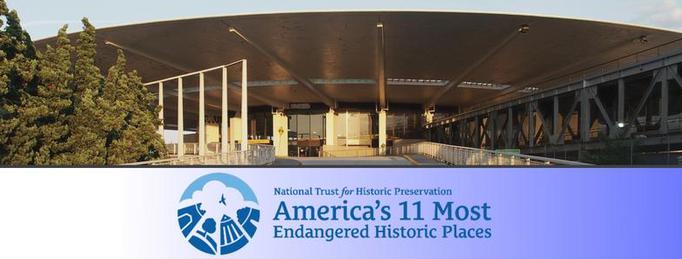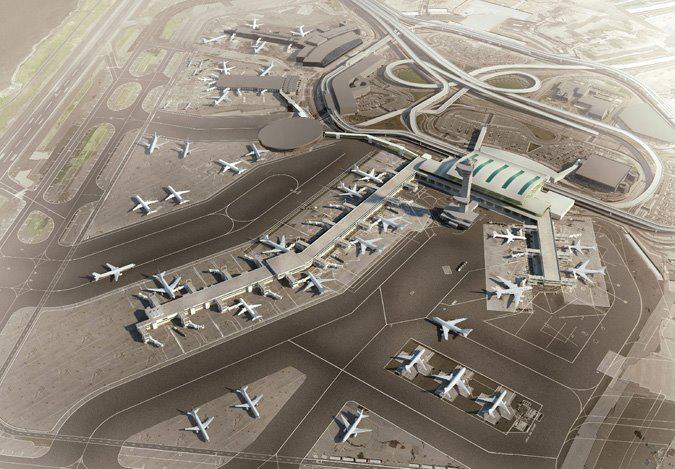We are grateful that the Port Authority and Delta Air Lines have acknowledged our campaign to save the iconic and historic former Pan Am Worldport at JFK.
Sadly the message we get from this press release is that the terminal will be demolished as planned, and at some point, the two organizations will come up with some way to commemorate it. But the details of what and where this tribute will actually be are unclear. Photographs and scale models were cited as possible components (but why bother with scale models when the Port Authority is still in possession of the actual full-scale Milton Hebald Zodiac sculptures that were removed from the terminal in 1991.)
We just want to say that while we appreciate the initiative to create a tribute, there really is no substitute for the real thing. Our motivation to save and restore the building is so it can continue serving a useful function, while at the same time providing the opportunity to experience it in real life. If one has never stood underneath that massive cantilevered roof, there is no way a photograph can convey the feeling. To put this into perspective, photographs of the Roman Colosseum or the Grand Canyon can easily be found on Google. Yet millions of people per year visit the Colosseum and the Grand Canyon in person for the experience of being there. What is the point of tourism, then, if society begins to feel contented that photographs are enough?
In response to requests by the media for statements, the two organizations have been providing prepackaged responses which have generally been making the same three arguments: Terminal 3 is obsolete; the Terminal 3 redevelopment will create jobs and drive the economy; the airport is so land-constrained that further preservation is impractical. This particular press release further states that preserving the structure will result in a loss of jobs, lead to passenger delays, and curtail future expansion of JFK airport.
We would like to share our counter-arguments.
With respect to the obsolescence of Terminal 3, we acknowledge that the terminal was never designed to handle passenger loads and security requirements on the scale of what it had been handling recently.
But what the press release does not indicate is that we are advocating to save only the original flying saucer portion, which takes up a fraction of the Terminal 3 space. We feel just this portion of the terminal can be restored and re-purposed for non-aviation uses, and will still drive job creation and growth.
The press release states that Delta's full redevelopment plan will generate more than 10,000 jobs in the region by 2014, including 200 construction jobs throughout the abatement, demolition and redevelopment of Terminal 3. So that implies that only 200 temporary jobs will be created, which will then cease to exist after 2014. The other 9,800 jobs we can only assume would exist regardless of what happens with Terminal 3.
Let's consider if the flying saucer section would be saved and re-purposed instead. The 200 temporary jobs would still be created, since abatement would need to be done regardless of outcome, and the rear section of the terminal which is neither iconic nor historic could still be demolished. This resulting space would still need to be repaved, and all ancillary work with respect to this project would still need to be done.
Once the project is completed, Delta and other airlines would still benefit from 13 out of the proposed 16 hardstands (only about 3 would be lost due to the flying saucer remaining in place.) These 13 hardstands would still fulfill Delta's objectives to decrease passenger delays and increase operational efficiency by having aircraft parked and serviced nearby.
If the flying saucer is kept and restored, would it not require additional jobs to be created for architects, engineers, renovators and construction workers? Would the resulting newly-renovated building not generate useful space where even more jobs would be created for services, maintenance and security? These would be sustainable jobs, not temporary jobs as with construction, demolition and paving.
Next, let's examine the land-constrained nature of JFK and future airport growth. From Delta's own lease and its operating agreement with JFK-IAT, the Terminal 3 property consists of 48 acres of land. The flying saucer's roof occupies only 4 of those 48 acres, and is situated close to land-side, so it will have minimal impact on aircraft movement around the proposed hardstands or on the operation of Terminals 2 and 4.
Speaking of Terminal 2, we understand that Delta is further expanding Terminal 4 by an additional 75,000 sq. ft. to provide 11 more gates for regional operations by 2015. Since JFK is slot-controlled by the FAA, it is reasonable to expect that after this expansion is completed, Delta will move any remaining operations from Terminal 2 to this new facility and abandon Terminal 2. Terminal 2 can then be demolished as well to make room for additional future expansion or more parking. So if the rear section of Terminal 3 is reclaimed and Terminal 2 is reclaimed, that is a vast open space for future expansion. Yet the flying saucer only takes up 4 acres and can still be useful for other needed services and provide more - not fewer jobs - for the airport.
And finally, we should address that the former TWA Flight Center at JFK was saved and restored. We are very grateful that the TWA building was saved. It is a magnificent building and one of Saarinen's most memorable works. Yet it has been sitting empty for nearly 12 years not collecting any rent. The very nature and design of that building makes it difficult to adapt. But after studying the layout of the Worldport's flying saucer and rotunda, we feel it is a much more adaptable structure for alternative uses so that it will more easily attract potential investors and tenants.
We don't have the numbers and million dollar studies, but at face value, most of what this press release is claiming just doesn't make sense.
In our opinion, the only fitting tribute for the Worldport's historic and iconic flying saucer we can think of is the real thing: itself.
The campaign to save the historic Flying Saucer at John F. Kennedy International Airport's Terminal 3.




